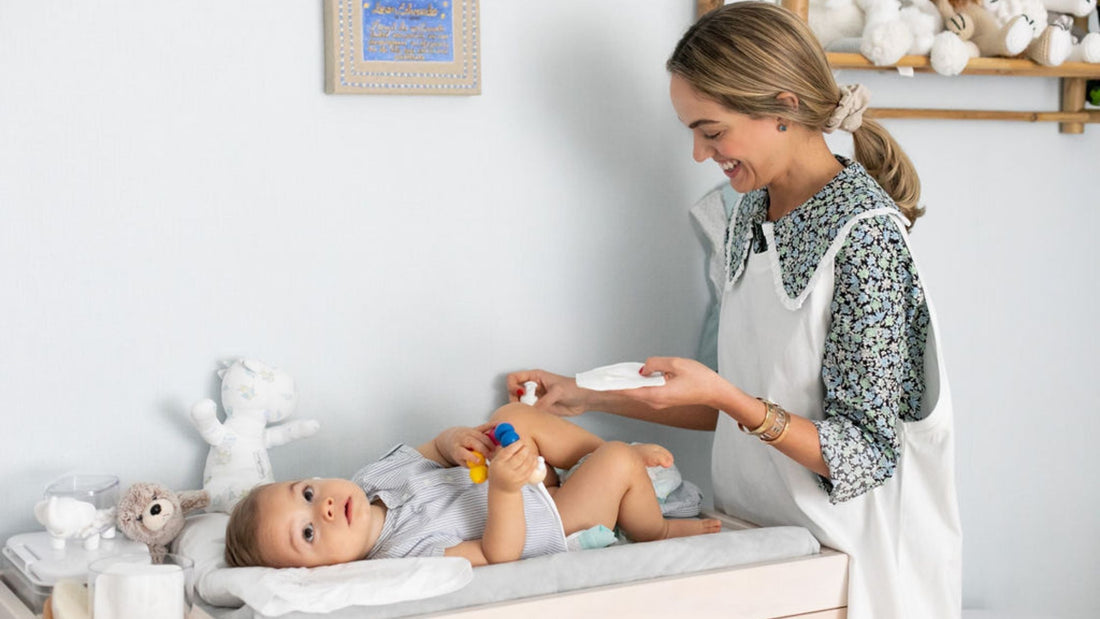
Why Experts Advise Against Using Baby Powder or Cornstarch on the Diaper Area
Share
Baby powder used to be a household staple for many families. However, we now know that baby powder isn’t the best option for babies due to the health risks of talc. This has some parents reaching for another household staple: cornstarch. Is cornstarch powder a safer swap for baby powder?
Let’s see what the experts have to say.

The dangers of talcum powder
Traditional baby powders contain talcum powder. Talcum powder is made from talc, a mineral that is formed by magnesium, silicon, and oxygen. Some talc contains asbestos. This toxic ingredient isn’t included intentionally but is present because talc mines are located where asbestos naturally occurs, causing talc to be contaminated.
Studies have linked asbestos to lung and ovarian cancer. Johnson & Johnson has faced several lawsuits regarding the link between their baby powder, cancer, and other side effects.
Inhaling talc can also irritate the lungs and respiratory system. A baby’s lungs are even more vulnerable to irritation, making talcum powder a particularly dangerous choice. Even if carefully applied, particles in the air can reach their nose and mouth.
Is cornstarch a safer alternative to baby powder?
Unlike talcum powder, cornstarch is a food-based substance that many consider a gentler option. It helps absorb moisture and reduce friction, which in theory makes it a good option for preventing diaper rash.
But is it really safer?
Doctors warn that cornstarch particles, like talc, can become airborne and be inhaled, potentially causing respiratory issues. While cornstarch isn’t contaminated with asbestos, it can still harm your little one’s airways.
Additionally, using cornstarch in the diaper area may feed yeast, worsening yeast-based rashes. For this reason, pediatricians generally advise against using cornstarch for baby rash, especially if there is a chance of yeast involvement.
So while some may ask, "Can you use cornstarch instead of baby powder?", the answer from most health professionals is to avoid powders entirely.
Is Cornstarch Safe to Use on Babies?
There are better options. Although cornstarch powder for babies might seem like a natural solution, it still poses risks. So if you’re wondering, "Is cornstarch baby powder safe?", consider that its potential to worsen rashes or cause breathing issues outweighs the possible benefits.

Do you need to use baby powder when changing a diaper?
The American Academy of Pediatrics (AAP) recommends a simple, powder-free approach:
-
Cleanse gently with water or a non-toxic cleansing cream.
-
Moisturize with a product that supports the skin’s natural barrier.
-
Treat and prevent diaper rash with a safe, effective ointment if needed.
Our 3-in-1 diaper care cleansing cream handles all three of these steps with one non-toxic product. It can be applied with cloth wipes, dry wipes, or a disposable organic cotton cleansing pad.
By sticking to these basics and changing diapers promptly, you can support healthy, hydrated skin without the need for powders.
Why moisturized skin is best
A common misconception is that dry skin equals healthy skin. But overly dry skin can crack and chafe, creating the perfect conditions for irritation and rash. Clean, well-moisturized skin protects your baby's skin microbiome.

Common questions about cornstarch baby powder
Can you use cornstarch instead of baby powder?
Experts advise against it. Both can irritate lungs and worsen yeast infections.
Corn starch for baby rash: does it help?
It may absorb moisture, but it can also feed yeast and worsen rashes. Pediatricians generally advise against it.
Is cornstarch baby powder safe?
Corn starch is safer than talc because it doesn’t contain asbestos, but still not recommended due to respiratory and yeast concerns.
Cornstarch powder dangers: what are they?
When using any baby powder, even cornstarch-based powder, there is a risk of lung irritation and yeast rash complications.
Cornstarch for baby eczema: is it okay?
It's best to avoid cornstarch and powders, especially if your baby has eczema. Opt for fragrance-free, non-irritating moisturizers instead.
Cornstarch in diaper: yes or no?
No—experts recommend keeping the area clean and moisturized without powders. A cleansing cream is a great alternative.

1 comment
This has totally SAVED my littlest skin! We went from open bleeding sores on her diaper area and had tried EVERY cream and remedy on the market and then some. Within less then 2 days of using Noleo it was completely healed. I just wish I would have found it sooner!!!